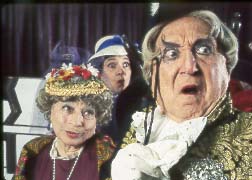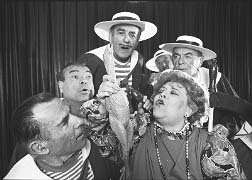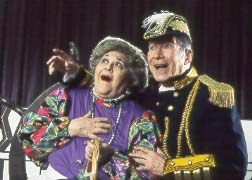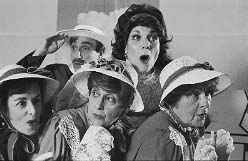
THINK BRITISH, SING YIDDISH
Yiddish adaptation of "H.M.S. Pinafore" has New York premiere.

| |
| L-R: Murray Nesbitt (R), with Evelyn Robb and Marilyn Sporty, in "Der Yiddisher Pinafore." (Photo by Jonathan Slaff) | |
August 12, 13, 19, 20, 26, 27
Theater at the New 14th Street Y, Sol Goldman Y of the Educational Alliance, 344 E. 14th Street
Presented by The Gilbert and Sullivan Yiddish Light Opera Company
Saturdays at 8:30 pm, Sundays at 2:00 pm and 7:00 pm
$30, group sales and advance sale discounts available
Smarttix, (212) 532-8887, WWW.SMARTTIX.COM
Yiddishe Savoyards, nu? We are happily living in the midst of a Klezmer music revival, which obscures the fact that there hasn't been an original development in Yiddish musical theater in quite some time. Not that Frank London (The Klezmatics) and others haven't scored interesting works for the theater recently, notably the puppet-filled "The Memoirs of Gluckel of Hameln" at La MaMa this past season. But when we say musical theater, we're talking about shows where the songs are interpolated into the plot. To do this in Yiddish for today's English-speaking audiences is quite a trick, but the Gilbert and Sullivan Yiddish Light Opera Company has done it quite successfully with its adaptations of three Savoy operas. The grandest of these, Der Yiddisher Pinafore," is about to have its New York premiere August 12-27 in the Theater at the New 14th Street Y, on the edge of the historic Yiddish Theater District.
"Der Yiddisher Pinafore" is based on "H.M.S. Pinafore" by Gilbert & Sullivan (1878), adapted by Bob Tartell and Al Grand. The songs are in Yiddish, the dialogue is in English and the plot is bent just a bisl in this novel adaptation, which has been widely performed outside Gotham and is newly directed for its New York premiere by Georgia McGill.

| |
| "So, I switched some babies years ago. Don't ask! Have a rubber chicken." | |
"Der Yiddisher Pinafore" takes the classical story of a poor young sailor's love for a rich Captain's daughter and adds a Jewish twist: what's separating the lovers is not class, but religion. It's all resolved at the end, in classic Yiddish theater style, when Little Buttercup (Kleyne Putershisl) reveals that the Der Kapitan and the sailor (re-named from Raphe to Labe) were switched as newborns, asserting "So, I switched some babies years ago. Don't ask! Have a rubber chicken." Throughout the play, the delicious Victorian wit and satire of Gilbert and Sullivan are blended with Jewish humor and the rhythms of Yiddish to create a new, unique theater experience.
Out-of-town reviews to-date have kvelled for the show. Arlene Ehrlich wrote in the Baltimore Jewish Times, "'Pinafore' is the classiest vessel afloat, and the funniest, for that matter, since the Marx Brothers stuffed a stateroom 50 years ago en route to the opera." She declared, "Yiddish theater comes roaring back to life: the extravagant gestures and shameless mugging, the noisy audience involvement, the 'in-jokes' that will never play in Peoria and the madcap indifference to high culture and pretension." She encouraged non Yiddish-speaking audiences to see the show, writing, "You don't have to speak Yiddish to enjoy the production any more than you have to be fluent in Italian to understand 'Aida.'" Isaac Asimov, writing on the company's "Di Yam Gazlonim" (Pirates of Penzance) for American Theater in 1989, declared the translation "keeps the rhymes, the lilt and the wit" of the original version and marveled at the unlikely similarity of Victorian British and Jews of any time or place when it comes to self-mockery.

| |
| L-R: Roz Gertz and co-translator/producer Bob Tartell in "Der Yiddisher Pinafore." (Photo by Jonathan Slaff) | |
The repertory of The Gilbert and Sullivan Yiddish Light Opera Company also includes "Der Yiddisher Mikado" (1987) and "Di Yam Gazlonim" (Pirates of Penzance) (1989). With 51 members, it is double- or triple-cast in all its productions and performs with rotating casts. Its performers include several cantors and retired opera singers, three retired dentists, a law professor, a psychology professor, and numerous ex-schoolteachers. Rokhl, the Captain's Daughter, is played by Arlene Kane, a rebbetzin, Ricki Zibitt, who teaches in a Yeshiva, and Gloria Montlack, a voice teacher. The young sailor is played by Al Barouch, a cantor who is also Musical director, and Ethan Fran, who is is young enough to be the son of many in the company and just wanted a chance to sing G&S. Most of the performers are Jewish and remember Yiddish as their parents' language. Producer Bob Tartell, who adapted "Pinafore" and "Mikado" with Al Grand, appears as Der Kapitan.
The troupe is actually an outgrowth of a G&S company on Long Island which, in 1977, discovered a 1952 adaptation of "H.M.S. Pinafore" into Yiddish by Miriam Walowit. Titled "Der Shirtz" (The Apron), it had been the basis for a production at the Kadimah Hadassah in Brooklyn, which originally staged it as a charity benefit and cut a 78 rpm record with twelve of its songs. In 1977, the company obtained performance rights to Ms. Walowit's "Mikado" and began adapting original productions of the other two operettas. By 1980, the group over-ruled its G&S purists and turned into all-Yiddish company now named the Gilbert and Sullivan Yiddish Light Opera Company. Murray Nesbitt, a veteran of the Light Opera Company of the Provincetown Playhouse, Blue Hill Troupe and Village Light Opera Group, plays Der Admiral in "Pinafore." He testifies that he feels he is "putting another nail in Hitler's coffin" each time he sings:
(When I was a lad I served a term)
hob ikh gearbayt far an advokat
(as office boy to an attorney's firm)
Khob gevisht di fenster mit a lek un a shmir
(I cleaned the windows and I swept the floor)
Un upgepolisht der hentlakh fun der groyser tir
(And I polished up the handle of the big front door)
Khob geribn un geribn mit azoy fil kraft
(I polished up that handle so carefullee)
Az men hot mir bald a hekhere job geschaft!
(That now I am the ruler of the Queen's Navee!)
Although the troupe is Long Island-based, this production is having its New York City premiere. It has toured to London, Toronto, Winnipeg, Seattle, Richmond, Baltimore, Washington, DC, New Jersey, Connecticut, Massachusetts, Maryland and Florida. Most of its performances are benefits; the company has raised money for charities including ecumenical soup kitchens, rebuilding Tel Aviv after Iraqi bombardments and endowing a chair in Judaica at University of Toronto. Reviewing "Der Yiddisher Mikado" at the Steiner Institute in London, Mendele Internet (Joan Martyr) wrote, "The audience, who are already asking where they can buy tickets for next year's tour, were thrilled by the brilliant staging, the bright energetic rendering of the text into Yiddish and English, the beautiful costumes and the faultless ensemble work."

| |
Chauncey Howell of New York's Channel 4, having seen several of the company's works, declared "What do you want, the D'Oyly Carte? This is better. BETTER." He called the work "more humorous and haymish," admired "the ganze ensemble" and declared "I love them. You talk about kvell, I was thrilled.
Director Georgia McGill is Artistic Director of the Modern Theatre of Myth and Professor of Theatre at CUNY/Queensboro. In 1991, her production of "Oedipus" appeared at the ancient theatre of Epidaurus, making her the first American director to be honored with a production at that ancient site. She was a featured artist at the International Theater Institute's festival in Cyprus in 1996 and directed "The Bacchae" at the International Festival of Budapest in 1998. She joined the Gilbert & Sullivan Yiddish Light Opera Company as a director in 1995 and staged its New York premiere of "Der Yiddisher Mikado" at the American Jewish Theater in 1998.
Oh, yes...it's all happening on the edge of the old Yiddish Theater Distirict of the Lower East Side. Most of the grand old kosher restaurants are gone, but the location is within walking distance of the Second Avenue Deli (located at East Tenth Street and Second Avenue). The East Village dining "strip" is also accessible, with a variety of high-quality Polish, Indian and Middle Eastern restaurants nearby on First and Second Avenues. [NYTW]
| home |
listings |
columnists |
reviews |
what's new? |
cue-to-cue |
people page |
welcome |
| museums |
recordings |
what's cool? |
who's hot? |
coupons |
publications |
classified |